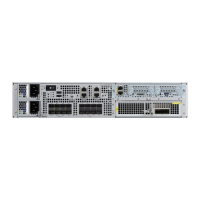Configuration on PE1
controller T3 0/3/0
clock source line
cablelength 224
configuration on CE2
controller T3 1/0/1
clock source line
cablelength 224
t1 1 channel-group 1 timeslots 1-24
Configuration on PE2
recovered-clock configuration:
recovered-clock 0 3
clock recovered 1 adaptive cem 0 1
configuration for applying recovered clock to controller:
controller T3 0/3/0
cablelength 224
t1 1 cem-group 1 timeslots 1-24
t1 1 clock source Recovered 1
Verifying Clock Recovery
To verify clock recovery, use the show recovered-clock command.
Router# show recovered-clock
Recovered clock status for subslot 1/0
----------------------------------------
Clock Mode Port CEM Status Frequency Offset(ppb)
1 ADAPTIVE 0 1 HOLDOVER 0
Router# show recovered-clock
Recovered clock status for subslot 1/0
----------------------------------------
Clock Mode Port CEM Status Frequency Offset(ppb)
1 ADAPTIVE 0 1 ACQUIRING -694
Configuring Out-of-Band Clocking
A TDM network requires a synchronized clock at each end of the connection (source and destination). This
means that the source and destination clock signals must be synchronized with each other in order to maintain
data integrity on the communication link.
On the other hand, a packet-switched network (PSN) does not use a clocking strategy, which means that the
PSN does not provide frequency synchronization between the source and the destination routers. Therefore,
to transmit TDM data across a PSN (such as an MPLS network), we need a way to deliver the clocking signal
between the source and the destination routers.
Cisco ASR 1000 Series Aggregation Services Routers SIP and SPA Software Configuration Guide, Cisco IOS
XE Everest 16.5
522 OL-14127-17
Configuring the Circuit Emulation over Packet Shared Port Adapter
Verifying Clock Recovery

